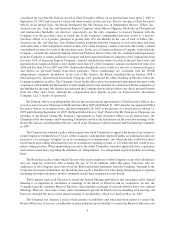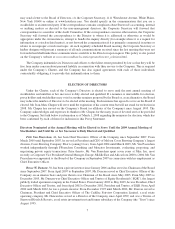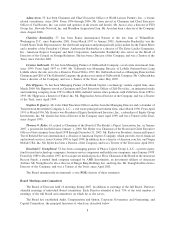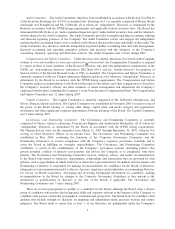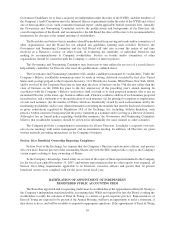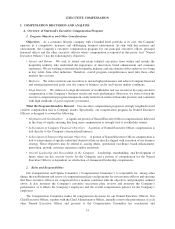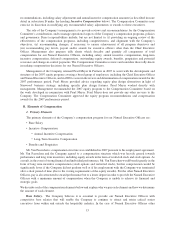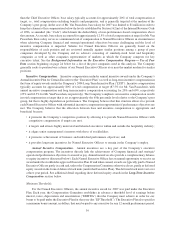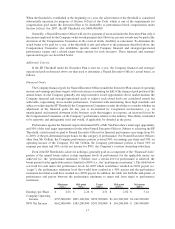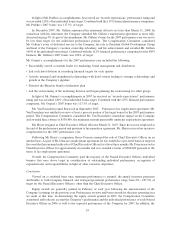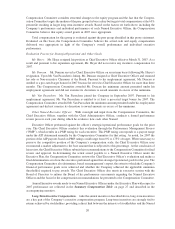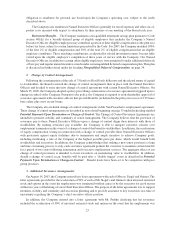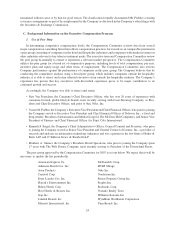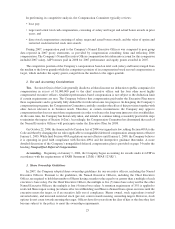Starwood 2007 Annual Report Download - page 27
Download and view the complete annual report
Please find page 27 of the 2007 Starwood annual report below. You can navigate through the pages in the report by either clicking on the pages listed below, or by using the keyword search tool below to find specific information within the annual report.recommendations, including salary adjustments and annual incentive compensation amounts (as described in more
detail in subsection B under the heading Incentive Compensation below). The Compensation Committee may
exercise its discretion in modifying any recommended salary adjustments or awards to these executives.
The role of the Company’s management is to provide reviews and recommendations for the Compensation
Committee’s consideration, and to manage operational aspects of the Company’s compensation programs, policies
and governance. Direct responsibilities include, but are not limited to, (i) providing an ongoing review of the
effectiveness of the compensation programs, including competitiveness, and alignment with the Company’s
objectives, (ii) recommending changes, if necessary, to ensure achievement of all program objectives and
(iii) recommending pay levels, payout and/or awards for executive officers other than the Chief Executive
Officer. Management also prepares tally sheets which describe and quantify all components of total
compensation for our Named Executive Officers, including salary, annual incentive compensation, long-term
incentive compensation, deferred compensation, outstanding equity awards, benefits, perquisites and potential
severance and change-in-control payments. The Compensation Committee reviews and considers these tally sheets
in making compensation decisions for our Named Executive Officers.
Management of the Company retained Pearl Meyer & Partners in 2007 to assist with the development and
structure of the 2007 equity program covering a broad group of employees, including the Chief Executive Officer
and Named Executive Officers, and in 2008 to assist in the review and determination of compensation awards for the
2007 performance period. Pearl Meyer provided advice regarding equity plan design alternatives in light of
Starwood’ business strategy, including specific plan design features. Pearl Meyer worked directly with
management. Management recommended the 2007 equity program to the Compensation Committee based on
the work developed in conjunction with Pearl Meyer. Pearl Meyer does not provide any other services to the
Company. The Compensation Committee approved the equity program recommendations and compensation
awards for the 2007 performance period.
B. Elements of Compensation
1. Primary Elements
The primary elements of the Company’s compensation program for our Named Executive Officers are:
• Base Salary
• Incentive Compensation
OAnnual Incentive Compensation
OLong-Term Incentive Compensation
• Benefits and Perquisites
Mr. Van Paasschen’s compensation structure was established in 2007 pursuant to his employment agreement.
Mr. Van Paasschen and the Company agreed to a compensation structure which was heavily geared towards
performance and long term incentives, including equity awards in the form of restricted stock and stock options. As
a result, in the event of strong financial and individual performance, Mr. Van Paasschen would benefit greatly in the
form of long term incentive compensation (stock options and restricted stock), but his compensation would be
significantly lower if the Company did not perform well or if his employment with the Company was terminated
after a short period of time (due to the vesting requirements of the equity awards). For the other Named Executive
Officers, pay is also structured to award performance but to a lesser degree in order to provide the Named Executive
Officers with a minimum amount of compensation when the Company is unable to achieve its financial and
strategic goals.
We describe each of the compensation elements below and explain why we pay each element and how we determine
the amount of each element.
Base Salary. The Company believes it is essential to provide our Named Executive Officers with
competitive base salaries that will enable the Company to continue to attract and retain critical senior
executives from within and outside the hospitality industry. In the case of Named Executive Officers other
15



